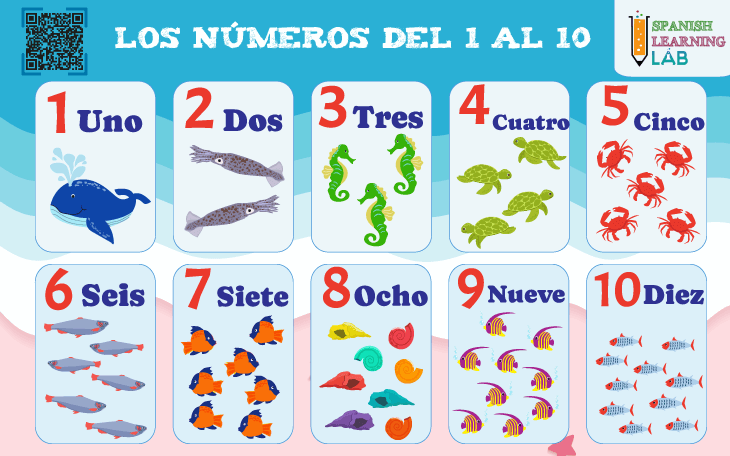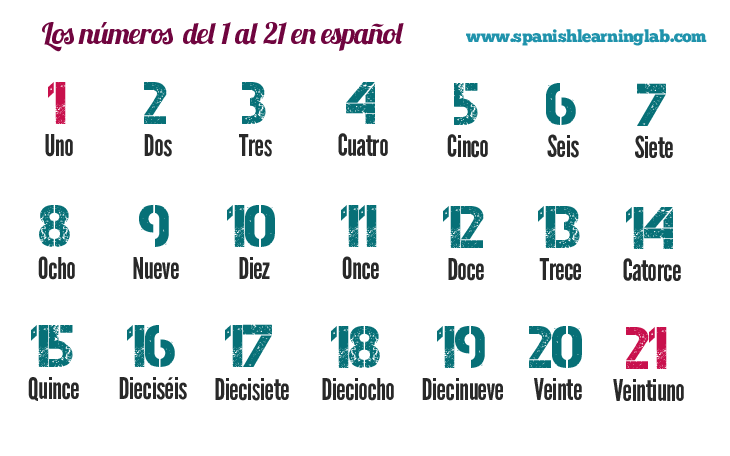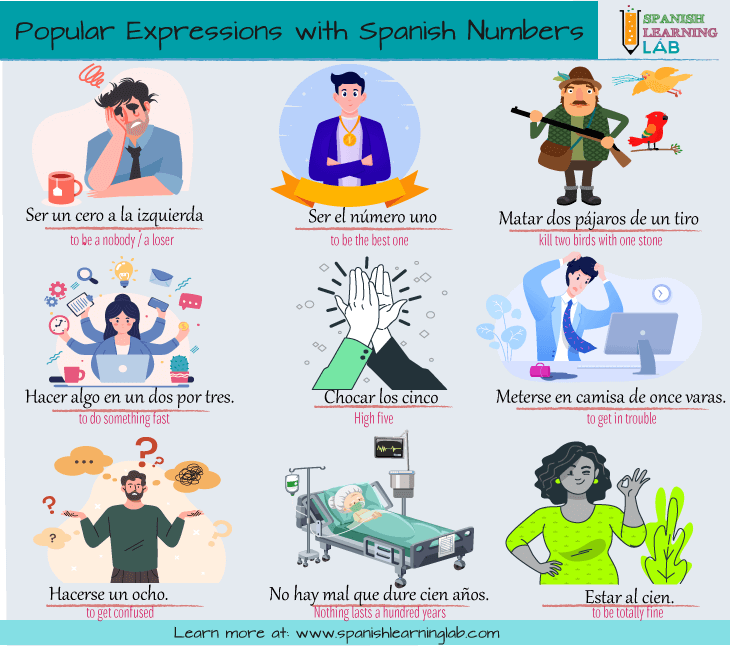The way we write and pronounce numbers is quite different from English, but they are still as important to give or get some personal information. In this lesson, we will learn how to spell and pronounce Spanish numbers 1-20, “los números del uno al veinte”. You will find a complete list with these numbers as well as some rules to form a few of them and remember them easily. The vocabulary will be used in sentences and questions, so you can see how useful they are for different situations in the language.
Writing and pronouncing Spanish numbers 1-10
LOS NÚMEROS or Spanish numbers can be divided in two main categories: cardinal and ordinal numbers. This lesson is about cardinal numbers, which are often used to share or get some personal information about ages, phone numbers and many other things. Spanish numbers 1-20 are all written differently, so we must memorize them because they are the basis for more complex numbers. UNO is a special case as it changes to UN when used before a masculine noun like CARRO (car), which means it would be correct to say “Un carro” (a car), but not “Uno carro”. The picture below uses sea animals (animales marinos) to show how to spell numbers from one to ten in Spanish.

Next, we will show you how to pronounce these numbers with a set of sample questions and sentences using Spanish numbers 1-10. Listen to their pronunciation and pay attention to the way subject pronouns and possessive adjectives are used in some of the sentences. In addition, these sentences include some common irregular verbs like TENER(to have) and HAY (there is/there are). Press PLAY to listen to the examples.
|
UNO – Tengo una noticia importante para ti
ONE – I have important news for you
|
|
DOS – Tú tienes dos hermanos
TWO – You have two brothers
|
|
TRES – Yo tengo tres mascotas
THREE – I have three pets
|
|
CUATRO – Nosotros tenemos cuatro estudiantes
FOUR – We have four students.
|
| CINCO – Ella tiene cinco tareas nuevas FIVE – She has five students |
|
SEIS – Mi hija tiene seis años de edad
SIX – My daughter is six years old
|
|
SIETE – El siete es mi número favorito
SEVEN – Seven is my favorite number
|
| OCHO – Hay ocho tazas aquí EIGHT- There are eight cups here |
|
NUEVE – Hay nueve personas en la habitación.
NINE – There are nine people in the room.
|
|
DIEZ – Solo tenemos diez minutos
TEN – We have ten minutes left.
|
Making Sentences with Numbers in Spanish 11-20
The last group to complete our list of Spanish numbers 1-20 are those between 11 and 20, “los números del once al veinte”. They must be memorized too, but there is a simple pattern to follow for some numbers, particularly from 16 to 19. All you need to do is join the prefix DIECI- plus a SEIS, SIETE, OCHO or NUEVE. However, the number “dieciséis” is a special case because it needs a tilde over the “é”. The chart below shows how to pronounce and spell Spanish numbers 11-20, and shows how they can be used in meaningful sentences and questions. Again, we will be using the verbs TENER and HAY in these examples.

|
ONCE – Él tiene once juguetes
He has eleven toys
|
|
DOCE – El perro tiene doce años
The dog is twelve years old
|
|
TRECE – Yo solo tengo trece dólares
I only have thirteen dollars
|
|
CATORCE – Ellos tienen catorce nietos
They have fourteen grandchildren
|
|
QUINCE – Yo compré quince libros.
I bought fifteen books
|
|
DIECISEIS – ¿Ya tienes dieciséis años?
Are you sixteen now?
|
|
DIECISIETE – Yo tengo diecisiete años.
I am seventeen years old.
|
|
DIECIOCHO – Nuestra clase tiene dieciocho estudiantes
Our class has eighteen students
|
|
DIECINUEVE – Hay diecinueve gatos en el refugio
There are nineteen cats in the shelter
|
|
VEINTE – Ellos tienen veinte aves en el refugio
They have twenty birds in the shelter
|
Popular expressions with numbers in Spanish
Pay attention to the following group of expressions with numbers in Spanish. These sayings or idioms are very popular in real conversations to speak in a more natural way, although their meaning cannot be taken literally sometimes, for example, instead of saying “Esto lo hago rápidamente” (I do this quickly), you could say “Esto lo hago en un dos por tres“, with no change in meaning.

Practice Time!
Here is an interactive quiz to practice recognition and spelling of Spanish numbers from one to twenty. Write the names of these numbers in the blanks, and then complete the sentences with the correct written form of the numbers in parentheses. You can practice even more with two worksheets on numbers in Spanish by following this link.
This is the end of this lesson. Hopefully, you will remember most Spanish numbers 1-20. If not, you can always come back to and review. In the next two lessons, we will learn numbers in Spanish from 21 to 100 and then numbers over 100. Before you leave, test yourself with this cool quiz. ¡Hasta pronto!
Related Spanish Worksheets:
- Ordinal Numbers in Spanish – PDF Worksheet
- Numbers in Spanish from 1 to 20 – PDF Worksheet
- Numbers in Spanish from 20 to 100 – PDF Worksheet
- Spanish Numbers 1-20 – PDF Word Soup
The audio for 1-5 is does not match the sentences.
Thanks a lot! FIXED 🙂
Yeah that is so nice